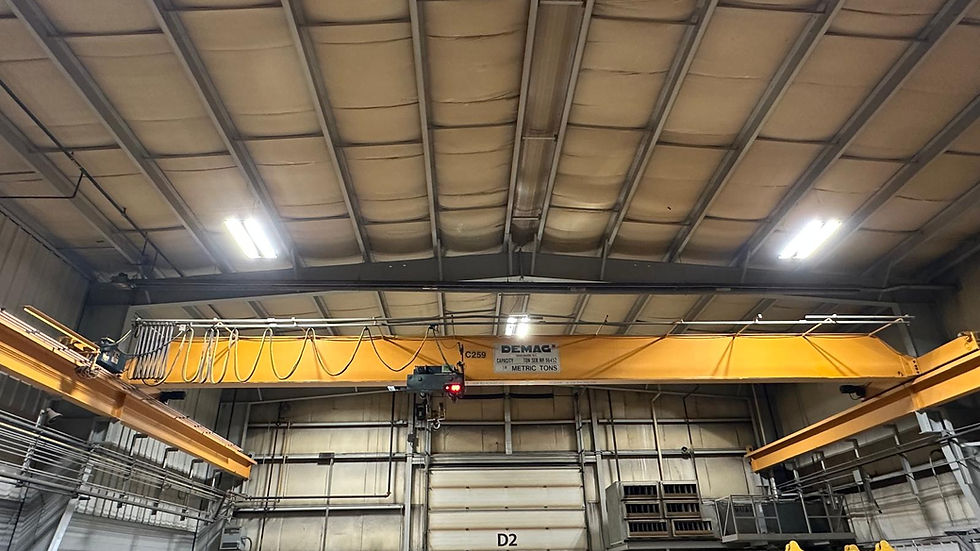Safe Lifting Equipment for Industrial Workplaces
- Brad Sliedrecht

- Sep 26
- 4 min read
Updated: Oct 10
When it comes to industrial workplaces, safety is not just a priority—it is a necessity. Handling heavy loads requires precision, care, and the right tools. Overhead cranes, hoists, and other lifting equipment are essential in many industries. However, without proper safety measures, they can become hazards. I want to share practical insights on how to keep your workplace safe and productive with the right equipment and practices.
Why Industrial Lifting Safety Matters
Industrial lifting safety is critical for protecting workers and maintaining smooth operations. Accidents involving lifting equipment can cause serious injuries, damage to goods, and costly downtime. Every business that uses cranes or hoists must prioritize safety to avoid these risks.
Safety starts with understanding the equipment and the environment. Loads must be lifted correctly, and equipment must be inspected regularly. Training workers on safe lifting techniques is equally important. When safety is ignored, the consequences can be severe.
By focusing on industrial lifting safety, you reduce the chance of accidents. You also improve efficiency. Workers feel confident using equipment that is reliable and well-maintained. This confidence translates into better productivity and fewer interruptions.

Key Practices for Industrial Lifting Safety
To ensure industrial lifting safety, you need a clear plan and consistent execution. Here are some key practices that I recommend:
Regular Inspections: Check cranes, hoists, and slings before every use. Look for wear, cracks, or damage.
Proper Training: Train all operators and workers on how to use lifting equipment safely. Include emergency procedures.
Load Limits: Never exceed the rated capacity of your equipment. Know the weight of your loads.
Clear Communication: Use signals or radios to coordinate lifts. Everyone involved should know the plan.
Safe Environment: Keep the lifting area free of obstacles and hazards. Ensure good lighting and stable footing.
These steps are simple but effective. They help prevent accidents and keep your equipment in top shape.
What are the Safety Equipment for Weightlifting?
When it comes to weightlifting in industrial settings, safety equipment is your first line of defense. Here are some essential items:
Overhead Cranes and Hoists: These machines handle heavy loads safely when used correctly. They reduce manual lifting and the risk of injury.
Slings and Shackles: Used to secure loads, these must be strong and inspected regularly. Choose the right type for your load.
Load Indicators and Limiters: Devices that alert operators if the load is too heavy or if the equipment is reaching its limit.
Safety Hooks and Latches: Prevent loads from slipping off during lifting.
Personal Protective Equipment (PPE): Helmets, gloves, steel-toed boots, and high-visibility clothing protect workers during lifting operations.
Using the right safety equipment is non-negotiable. It ensures that every lift is controlled and secure.

Choosing the Right Equipment for Your Workplace
Selecting the right lifting equipment depends on your specific needs. Consider the type of loads, the frequency of lifts, and the working environment. Here are some tips to guide your choice:
Assess Load Types: Are you lifting bulky items, pallets, or machinery? Different loads require different equipment.
Capacity Matters: Always choose equipment rated for the heaviest load you expect to lift.
Environment Considerations: For outdoor or corrosive environments, select equipment with appropriate protection.
Ease of Use: Equipment should be user-friendly to reduce operator error.
Maintenance and Support: Opt for brands and suppliers that offer good after-sales service and easy access to parts.
Investing in the right equipment upfront saves money and headaches later. It also supports your goal of maintaining a safe workplace.
Maintaining Safe Lifting Equipment for Longevity
Maintenance is key to keeping your lifting equipment safe and reliable. Neglecting maintenance can lead to equipment failure and accidents. Here’s how to maintain your equipment effectively:
Scheduled Inspections: Follow manufacturer guidelines for inspection intervals.
Lubrication and Cleaning: Keep moving parts clean and well-lubricated to prevent wear.
Replace Worn Parts: Don’t wait for a failure. Replace any damaged or worn components immediately.
Record Keeping: Maintain detailed logs of inspections, repairs, and maintenance activities.
Professional Servicing: Use certified technicians for complex repairs and annual servicing.
Regular maintenance extends the life of your equipment and ensures it performs safely every time.

How safe lifting equipment Supports Your Business Goals
Using safe lifting equipment is more than a safety measure—it’s a business strategy. Reliable equipment reduces downtime and keeps your operations running smoothly. When your lifting gear is safe and efficient, you avoid costly delays and repairs.
Choosing trusted suppliers and brands ensures you get equipment that meets high safety standards. It also means you have access to expert support when you need it. This partnership helps you maintain compliance with safety regulations and industry best practices.
By prioritizing safe lifting equipment, you protect your workforce and your bottom line. It’s a smart investment that pays off in productivity and peace of mind.
Taking the Next Step in Industrial Lifting Safety
Safety is an ongoing journey, not a one-time task. Start by reviewing your current lifting equipment and safety procedures. Identify any gaps or risks. Then, take action to upgrade your equipment, train your team, and implement regular maintenance.
Remember, the right equipment combined with good practices creates a safer workplace. It also builds a culture where safety is valued and everyone plays a part.
If you want to learn more about how to improve your industrial lifting safety or need expert advice on equipment, reach out to trusted providers. They can help you find solutions tailored to your needs.
Safety is the foundation of productivity. Invest in it wisely.
Conclusion
In conclusion, prioritizing safety in industrial lifting is essential for the well-being of your workforce and the efficiency of your operations. By implementing key practices, using the right equipment, and maintaining it properly, you can create a safer workplace. Remember, safety is not just a requirement; it is a commitment to your team and your business.
Thank you for reading. Stay safe and lift smart!





Comments